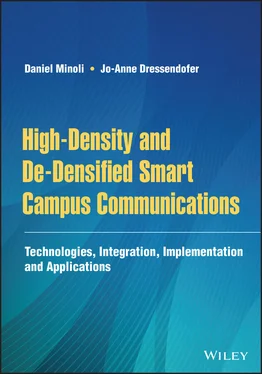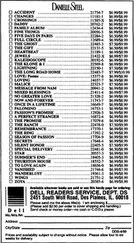JO‐ANNE DRESSENDOFER
Jo‐Anne (Josie) Dressendofer is the founder of SliceWiFi. The firm was launched in 2016 to address the rapidly expanding need for fast, reliable Wi‐Fi service in permanent and temporary locations. What started as a goal to become the first “Managed Wi‐Fi Brand” ended up becoming the first company to compete with the goliath cellular companies, with Wi‐Fi and an all‐inclusive technology, turning SliceWiFi into a telecommunications company overnight. SliceWiFi initially achieved market recognition in New York City, as one of the leading Wi‐Fi providers in the NY metro area, after successfully supporting difficult, densely populated networking environments such as the Javits Center and downtown Brooklyn rebuilding after Hurricane Sandy; NY Fashion Week's many simultaneous event locations; many hackathons with over a thousand users; the Staten Island Ferry during peak travel over the Hudson River; and the parks at Hudson Yards where no fiber was to be had. In 2017, SliceWiFi won CIO magazine's category award for “Top Wireless Solution Providers.”
Ms. Dressendofer has led a 25‐year career in the tech industry, competing aggressively and winning repeatedly against larger, better‐financed multi‐billion‐dollar competitors. Her firms have a record of being more creative with leading‐edge technology deployment and networking engineering than all the legacy providers in play. The recent win at BWI Thurgood Marshall Airport (BWI) against major players in the telecommunications industry was transcendent and proof that the SuperNetwork concept (Chapters 9 and 10) is not only a trendsetter but a victory for all women in technology.
In addition to the inventors cited in this work, Mr. Minoli wishes to warmly thank Mr. Benedict Occhiogrosso, President, DVI Communications, for the continued support and input in all the bleeding‐edge technologies discussed in this text. DVI Communications, Inc. is a leading and highly respected Information Technology, ICT consultancy, and systems engineering firm with core competencies in IT, ICT, IoT, M2M, wireless, telecom, security, and audiovisual systems. Throughout its 40+ year history, the firm has supported many organizations deploying traditional and emerging technologies, serving both large enterprises and smaller organizations in numerous vertical markets with complex, state‐of‐the‐art systems often working alongside legacy systems, supporting several generations of technology simultaneously.
Ms. Dressendofer wishes to credit and thank the staff of Slice Wireless Solutions, Inc. (SliceWiFi) for the support of this initiative, as described in Chapter 9and further synthesized in Chapter 10, in the context of designing and deploying a reimagined Thurgood Marshall Airport (BWI) SuperNetwork and the development of WiSNET. The complete redesign and the initial redeployment of the entire BWI Airport terminal‐side and some portions of the operations wireless communication infrastructure, amid the COVID‐19 pandemic and the span of 12 months, all while maintaining reliable, uninterrupted airport service, was an enormously complex task. Much has been learned at the practical level and is documented in the last two chapters of this book. John Hutzler, COO, and Ed Wright, CTO, have been instrumental in the successful design and completion of this SuperNetwork redeployment mission, even more so as evinced by the relatively small size and the recent debut of SliceWiFi, and this win against the competition backed by billions faced during the RFP process. Without their labor, there would be no SuperNetwork and no chapters to document herewith. Thanks to Cheryl Beck, CMO and Jeffrey Forester, our legal council.
Lastly, to those who were there before SliceWiFi and who without their contribution would never had led down the path of this incredible development. I especially owe that to Morris Williams, Jiamini Erskine, and Ricky Smith of BWI for having the courage to choose a better way not the old way and stay by our side during the tough times, our Nashville investors and investment team, Eddy Wong, my former partner and mentor, Irwin Cohen whose inspiration and endless contacts led me to the incredible support of Jason Zuckerbrod and Jody Westby, and my six nieces who inspired me every day to do more to open doors and make the world a better place for them. Thank you will never be enough for your help in creating a dream this big, against such odds and see it actualized. Dan Minoli you stand alone in genius and my admiration.
1 Background and Functional Requirements for High‐Density Communications
This introductory chapter covers two topics: (i) a basic introduction to the underlying technologies and principles that apply to High‐Density Communications (HDC), but not high‐density specifics, which are covered in the chapters that follow, and (ii) a discussion of the main requirements for HDC in the context of key use cases. Use cases include airports, stadiums, convention centers, classrooms, amusement parks, train and subway stations, large multiple dwelling units, open air special events, and other venues. 1
As the second decade of the twenty‐first century rolled along, however, a new requirement presented itself due to the worldwide pandemic: physical/desk distancing in support of Office Social 2 Distancing (OSD) and Office Dynamic Cluster Monitoring and Analysis (ODCMA). A “de‐densification” effort was established at the time. The de‐densification effort in the workplace impacts a large number of factors, including network connectivity services and architectures. Propitiously, wireless technologies have been harvested to address and manage these pressing distancing issues. Even if effective vaccines are found and distributed globally, many agree that some of the societal and workplace changes driven by the pandemic may become permanent. One change likely to remain is the increased reliance on Work From Home (WFH) and along with it, are the implications of greater utilization of a global workforce in what might be called Outsourcing 2.0 (with the 1.0 version having taken place in the 1990s and 2000s). However, “the sun will rise again,” and in a few years, people‐based HDC may yet again become the norm; in the meantime, a large population of Internet of Things (IoT) devices may indeed require HDC support, and during the pandemic, the e‐commerce warehouse use case continues to need HDC support. Thus, while “social distancing” was a short‐term goal at press time, the business‐ and public‐venue high‐density requirements are expected to resurge and/or continue over time. Further discussion of these issues is provided in the latter part of the chapter.
The principal ways people currently communicate (especially when away from home) are via 4G/Long‐Term Evolution (LTE) cellular access, for both voice and data, and/or via a public, institutional, or corporate Wi‐Fi™ hotspot. In less populated areas and while in motion, cellular access is typically the norm, rather than Wi‐Fi access. In large business and commercial buildings (e.g. skyscrapers, hospitals, hotels), internal systems known as Distributed Antenna Systems (DASs) may be used to provide better signal quality to cellular users; these systems interoperate with the public cellular network in a number of ways. When stationary, both choices may be available.
Cellular services are offered by carriers using specific carrier‐allocated Radio Frequency (RF) spectrum. Relatively high monthly fees are incurred; additionally, there may be both physical and administrative limits to the amount of bandwidth and interval‐accumulated throughput. Wi‐Fi makes use of bands that are freely allocated; services could be free or could be nearly free based on some account subscription arrangement.
Читать дальше












